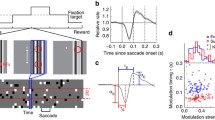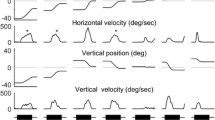Summary
In the alert monkey we have compared the properties of saccades elicited by a visual stimulus (V-saccades) with those generated by electrical stimulation in the superior colliculus (E-saccades). We found that whereas there exists a graded relation betweenE-saccade amplitude and current strength,E-saccade direction is remarkably independent of electrical stimulation parameters. At sufficiently high current strengths (about 20 μA),E-saccades are consistently directed toward the center of the movement field of nearby cells, except when stimulation is performed at sites near the collicular borders. Further interesting differences between the amplitude and direction behaviour were observed when the variability inE-saccade vectors, obtained with fixed stimulation parameters, was analyzed. In all cases,E-saccade amplitude scatter exceeds direction scatter, suggesting the possibility of a polar coordinate organization for the coding of saccade metrics. These data are compared withV-saccade scatter data, recently obtained in the human (Van Opstal and Van Gisbergen 1989 c). Finally, an analysis of saccade dynamics shows thatE-saccades can reachV-saccadic velocities at higher current strengths. However, at near-threshold current strengths, whereE-saccade amplitude decreases (see above), we found at most stimulation sites (22/37) thatE-saccades are consistently slower thanV-saccades of the same amplitude. Possible mechanisms underlying the collicular role in saccade generation are discussed.
Similar content being viewed by others
References
Alexander DE, Delong HR (1985) Microstimulation of the primate neostriatum. I. Physiological properties of striatal microexcitable zones. J Neurophysiol 53:1401–1416
Berthoz A, Grantyn A, Droulez J (1986) Some collicular efferent neurons code saccadic eye velocity. Neurosci Lett 72:289–294
Bour LJ, Van Gisbergen JAM, Bruijns J, Ottes FP (1984) The double magnetic induction method for measuring eye movement: results in monkey and man. IEEE Trans BME 31:419–427
Hikosaka O, Wurtz RH (1985) Modification of saccadic eye movements by GABA-related substances. I. Effects of muscimol and bicuculline in monkey superior colliculus. J Neurophysiol 53:266–291
Lee C, Rohrer WH, Sparks DL (1988) Population coding of saccadic eye movements by neurons in the superior colliculus. Nature 332:357–360
Mays LE, Sparks DL (1980) Dissociation of visual and saccade-related responses in superior colliculus neurons. J Neurophysiol 43:207–232
McIllwain JT (1975) Visual receptive fields and their images in superior colliculus of the cat. J Neurophysiol 38:219–230
McIlwain JT (1976) Large receptive fields and spatial transformations in the visual system. Int Rev Physiol 10:223–248
McIlwain JT (1982) Lateral spread of neural excitation during microstimulation in intermediate gray layer of cat's superior colliculus. J Neurophysiol 47:167–178
Munoz DP, Guitton D (1987) Tecto-reticulo-spinal neurons have discharges coding the velocity profiles of eye and head orienting movements. Soc Neurosci Abstr 13:Part 1, p 393
Ottes FP, Van Gisbergen JAM, Eggermont JJ (1986) Visuomotor fields of the superior colliculus: a quantitative model. Vision Res 26:857–873
Ottes FP, Van Gisbergen JAM, Eggermont JJ (1987) Collicular involvement in a saccadic colour discrimination task. Exp Brain Res 66:465–478
Robinson DA (1972) Eye movements evoked by collicular stimulation in the alert monkey. Vision Res 12:1795–1807
Rohrer WH, White JM, Sparks DL (1987) Saccade-related burst cells in the superior colliculus: relationship of activity with saccadic velocity. Soc Neurosci Abstr 13:1092
Schiller PH, Stryker M (1972) Single-unit recording and stimulation in superior colliculus of the alert rhesus monkey. J Neurophysiol 35:915–924
Sparks DL (1986) Translation of sensory signals into commands for control of saccadic eye movements: role of primate superior colliculus. Physiol Rev 66:118–171
Sparks DL, Mays LE (1980) Movement fields of saccade-related burst neurons in the monkey superior colliculus. Brain Res 190:39–50
Sparks DL, Mays LE (1983) Spatial localization of saccade targets. I. Compensation for stimulation-induced perturbations in eye position. J Neurophysiol 49:45–63
Sparks DL, Holland R, Guthrie BL (1976) Size and distribution of movement fields in the monkey superior colliculus. Brain Res 113:21–34
Stoney SD Jr, Thompson WD, Asanuma H (1968) Excitation of pyramidal tract cells by intracortical microstimulation: effective extent of stimulating current. J Neurophysiol 31:659–669
Van Gisbergen JAM, Van Opstal AJ, Tax AAM (1987) Collicular ensemble coding of saccades based on vector summation. Neuroscience 21:541–555
Van Opstal AJ, Van Gisbergen JAM (1987a) A nonlinear model of collicular spatial interactions possibly underlying saccadic averaging responses to electrical double stimulation. Neuroscience 22 (Suppl) S847
Van Opstal AJ, Van Gisbergen JAM (1987b) Nonhomogeneity and anisotropy in the topographical organization of the motor colliculus and saccade endpoint scatter. In: Luer G, Lass U (eds) Proceedings fourth European conference on eye movements. Hogrefe Ine, Göttingen, pp 114–116
Van Opstal AJ, Van Gisbergen JAM (1989a) A model for collicular efferent mechanisms underlying the generation of saccades. Brain Behav Evol 33:90–94
Van Opstal AJ, Van Gisbergen JAM (1989b) A nonlinear model for collicular spatial interactions underlying the generation of electrically elicited saccades. Biol Cybern 60:171–183
Van Opstal AJ, Van Gisbergen JAM (1989c) Analysis of variability in amplitude and direction of saccades. Vision Res 29:1183–1196
Wurtz RH, Goldberg ME (1972) Activity of superior colliculus in behaving monkey. III. Cells discharging before eye movements. J Neurophysiol 35:575–586
Author information
Authors and Affiliations
Rights and permissions
About this article
Cite this article
Van Opstal, A.J., Van Gisbergen, J.A.M. & Smit, A.C. Comparison of saccades evoked by visual stimulation and collicular electrical stimulation in the alert monkey. Exp Brain Res 79, 299–312 (1990). https://doi.org/10.1007/BF00608239
Received:
Accepted:
Issue Date:
DOI: https://doi.org/10.1007/BF00608239




